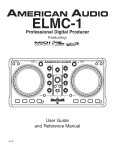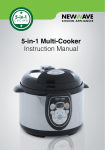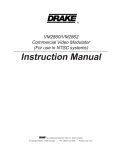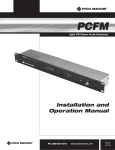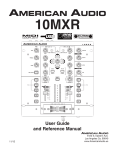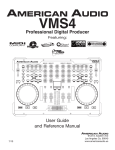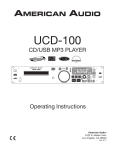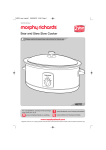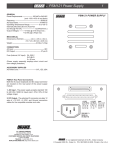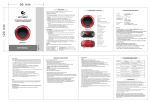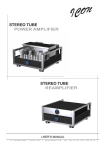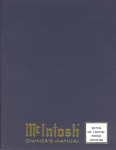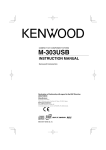Download DN-600F - Nordisk Musik AB
Transcript
STEREO CD PLAYER DN-600F OPERATING INSTRUCTIONS IMPORTANT TO SAFETY LABELS (for U.S.A. model only) WARNING: TO PREVENT FIRE OR SHOCK HAZARD, DO NOT EXPOSE THIS APPLIANCE TO RAIN OR MOISTURE. CAUTION: 1. Handle the power supply cord carefully Do not damage or deform the power supply cord. If it is damaged or deformed, it may cause electric shock or malfunction when used. When removing from wall outlet, be sure to remove by holding the plug attachment and not by pu0lling the cord. 2. Do not open the top cover In order to prevent electric shock, do not open the top cover. If problems occur, contact your DENON dealer. 3. Do not place anything inside Do not place metal objects or spill liquid inside the CD player. Electric shock or malfunction may result. Please, record and retain the Model name and serial number of your set shown on the rating label. Model No. DN-60OF Serial No. CAUTION: USE OF CONTROLS OR ADJUSTMENTS OR PERFORMANCE OF PROCEDURES OTHER THAN THOSE SPECIFIED HEREIN MAY RESULT IN HAZARDOUS RADIATION EXPOSURE. THE COMPACT DISC PLAYER SHOULD NOT BE ADJUSTED OR REPAIRED BY ANYONE EXCEPT PROPERLY QUALIFIED SERVICE PERSONNEL. NOTE: This unit may cause interference to radio and television reception if you do not operate it in strict accordance with this OPERATING INSTRUCTIONS. This unit complies with Class B computing device rules in accordance with the specifications in Sub-part J or Part 15 of the FCC Rules, which are designed to provide reasonable protection against such interference in a residential installation. If the unit does cause interference to any radio or television reception, try to reduce it by one or more of the following means: a) Turn the other unit to improve reception b) Move this unit c) Move this unit away from others d) Plug this unit respectively into a different AC outlet " This is note in accordance with Section 15.838 of the FCC Rules. FOR U.S.A. & CANADA MODEL ONLY CAUTION TO PREVENT ELECTRIC SHOCK DO NOT USE THIS (POLARIZED) PLUG WITH AN EXTENSION CORD, RECEPTACLE OR OTHER OUTLET UNLESS THE BLADES CAN BE FULLY INSERTED TO PREVENT BLADE EXPOSURE. POUR LES MODELES AMERICAINS ET CANADIENS UNIQUEMENT ATTENTION POUR PREVENIR LES CHOCS ELECTRIQUES NE PAS UTILI SER CETTE FICHE POLARISEE AVEC UN PROLONGATEUR UNE PRISE DE COURANT OU UNE AUTRE SORTIE DE COURANT, SAUF SI LES LAMES PEUVENT ETRE INSEREES A FOND SANS EN LAISSER AUCUNE PARTIE A DECOUVERT. NOTE: This CD player uses the semiconductor laser. To allow you to enjoy music at a stable operation, it is recommended to use this in a room of 5°C (41 °F) - 35°C (95°F). CLASS 1 LASER PRODUCT LUOKAN 1 LASERLAITE KLASS 1 LASERAPPARAT FRONT PANEL REAR PANEL 3 SAFETY INSTRUCTIONS 1. Read Instructions - All the safety and operating instructions should be read before the appliance is operated. 2. Retain Instructions - The safety and operating instructions should be retained for future reference. 3. 12. Power-Cord Protection - Power-supply cords should be routed so that they are not likely to be walked on or pinched by items placed upon or against them, paying particular attention to cords at plugs, convenience receptacles, and the point where they exit from the appliance. Heed Warnings-All warnings on the appliance and in the operating instructions should be adhered to. 14. Cleaning - The appliance should be cleaned only as recommended by the manufacturer. 4. Follow Instructions - All operating and use instructions should be followed 15. Power Lines-An outdoor antenna should be located away from power lines. 5. Water and Moisture - The appliance should not be used near water - for example, near a bathtub, washbowl, kitchen sink, laundry tub, in a wet basement, or near a swimming pool, and the like. 16. Outdoor Antenna Grounding - If an outside antenna is connected to the receiver, be sure the antenna system is grounded so as to provide some protection against voltage surges and built-up static charges. Article 810 of the National Electrical Code, ANSI/NFPA 70, provides information with regard to proper grounding of the mast and supporting structure, grounding of the lead-in wire to an antenna discharge unit, size of grounding conductors, location of antenna-discharge unit, connection to grounding electrodes, and requirements for the grounding electrode. See Figure A. 17. Nonuse Periods - The power cord of the appliance should be unplugged from the outlet when left unused for a long period of time. 18. Object and Liquid Entry - Care should be taken so that objects do not fall and liquids are not spilled into the enclosure through openings. Carts and Stands - The appliance should be used only with a cart or stand that is recommended by the manufacturer. 6A. An appliance and cart combination should be moved with care. Quick stops, excessive force, and uneven surfaces may cause the appliance and cart combination to overturn. 7. Wall or Ceiling Mounting -The appliance should be mounted to a wall or ceiling only as recommended by the manufacturer. 8. Ventilation -The appliance should be situated so that its location or position does not interfere with its proper ventilation. For example, the appliance should not be situated on a bed, sofa, rug, or similar surface that may block the ventilation openings; or, placed in a built-in installation, such as a bookcase or cabinet that may impede the flow of air through the ventilation openings. 9. 4 Damage Requiring Service - The appliance should be serviced by qualified service personnel when: A. The power-supply cord or the plug has been damaged; or B. Objects have fallen, or liquid has been spilled into the appliance; or Heat -The appliance should be situated away from heat sources such as radiators, heat registers, stoves, or other appliances (including amplifiers) that produce heat. 10. Power Sources-The appliance should be connected to a power supply only of the type described in the operating instructions or as marked on the appliance. 11. Grounding or Polarization - Precautions should be taken so that the grounding or polarization means of an appliance is not defeated. C. The appliance has been exposed to rain; or D. The appliance does not appear to operate normally or exhibits a marked change in performance; or 20. E. The appliance has been dropped, or the enclosure damaged. Servicing - The user should not attempt to service the appliance beyond that described in the operating instructions. All other servicing should be referred to qualified service personnel. NOTE ON USE: 5 Thank you for purchasing this DENON Compact Disc Player. Please read the operating instructions thoroughly in order to acquaint yourself with the CD player and achieve maximum satisfaction from it. TABLE OF CONTENTS FEATURES ..................................................................................6 NAMES AND FUNCTIONS OF PARTS .........................................7, 8 CONNECTION .............................................................................9 OPENING AND CLOSING THE DISC HOLDER AND LOADING A DISC .........................................................................9 NORMAL CD PLAYBACK ............................................................. 10 ADVANCED CD PLAYBACK ...................................................10 ~12 RC-41 REMOTE CONTROL UNIT ................................................. 13 TIMER-CONTROLLED PLAYBACK ................................................ 13 INSTALLATION PRECAUTIONS ................................................... 13 THE COMPACT DISC .................................................................. 14 TROUBLESHOOTING ................................................................. 14 SPECIFICATIONS ....................................................................... 14 Please check to make sure the following items are included with the main unit in the carton: (1) Operating Instructions ............................................................1 (2) Connection Cord ....................................................................1 FEATURES The DN-60OF Compact Disc Player incorporates DENON's Super Linear Converter which prevents deterioration of sound quality in PCM playback systems. This assures accurate reproduction of the digital signals recorded on compact discs no matter whether they are pure studio recordings or "live" performance recordings. All parts making up this CD player have selected with the greatest care in order to produce high quality realistic playback of the full musical content on compact discs. Double Super Linear Converter The use of DENON's unique system and D/A converters with excellent resolution to prevent zero cross distortion, the main cause of reduced sound quality in the PCM playback system, make for sound field reproduction with rich musical expression. (2) High Performance Digital Filter The DN-60OF uses independent D/A converters for the left and right channels and an 8x oversampling high precision digital filter to bring out the best of the analog filter and offer clear, crisp sound. (3) Simple Playback of 8cm CD Singles 8cm CD singles can be played without using an adaptor. (4) Digital Output (Coaxial) The data on the compact disc is output in digital form, so playback is possible with an external digital processor or D/A unit. IMPORTANT (CANADIAN MODEL ONLY) This digital apparatus does not exceed the Class B limits for radio noise emissions from digital apparatus setout in the Radio Interference Regulations of the Canadian Department of Communication. Line Voltage Selection (for multiple voltage model only) The desired voltage may be set with the VOLTAGE SELECTOR knob on the rear panel, using a screwdriver. Do not twist the VOLTAGE SELECTOR knob with excessive force as this may cause damage. If the VOLTAGE SELECTOR knob does not turn smoothly, please contact a qualified serviceman. 6 NAMES AND FUNCTIONS OF PARTS 1. Power Switch (POWER) When the power is turned on, "(00)" appears on the TRACK NO. display, and if no disc is loaded, "(00 oooo )" appears on the digital display. If the power is turned on with a disc already loaded, the total number of tracks on the disc is displayed on the TRACK N0. display, the total time is displayed on the TIME display, the numbers on the music calendar light up to the number of tracks on the disc, and playback begins. Whenever the power switch is in the OFF state, the apparatus is still connected on AC line voltage. Please be sure to unplug the cord when you leave home for, say, a vacation. 2. Disc Holder Place the disc on the disc holder with the label facing up. Use the open/close button to open and close the disc holder. The disc holder may also be closed by pressing the play button or pause button. 3. Open/Close Button The disc holder is opened and closed by pressing this button. Press this button once to open the disc holder, and once again to close it. When the disc holder is closed with a disc loaded, the disc will rotate for a couple of seconds while the disc contents are read. The number of tracks and total playback time on the disc are then displayed on the digital display. 4. Remote Control Sensor (REMOTE SENSOR) This sensor receives the infrared light transmitted from the wireless remote control unit. Point the separately sold RC-41 or RC-U620 remote control unit at this sensor when operating it. When a signal is transmitted from the remote control unit, the remote control indicator in the display will light up briefly. 5. Display The digital display is divided into sections, such as displays for track number, playback time and calendar, as shown below. 7. Stop Button Press this button to stop playback. The disc will stop rotating, and the number of tracks and total playing time of the disc are displayed on the TRACK NO. and TIME displays, respectively. • In case programmed playback is engaged when this button is pressed, the number of tracks and total playing time of the program are displayed. 8. Pause Button Press this button to stop playback temporarily. • If this button is pressed during playback, playback is stopped temporarily, the PLAY indicator goes out and the PAUSE indicator lights. Press this button or the play button again to continue playback. 9. Number Buttons (1, 2, 3, 4, 5, 6, 7, 8, 9 and 10) Use these buttons for the direct search and program memory functions. For direct search, press for example button 03 if you want to hear track number 3. For track number 12, press +10 then 2. To program tracks, press the PROG/ DIRECT button 10 to set to the program mode. 10. Program Button (PROG/DIRECT) Press this button when you want to enter tracks for programmed playback. (Refer to page 10, 11 for details.) 11. Auto Edit Button (A. EDIT) • The tracks on a CD are automatically split into two halves, Side A and Side B, like an analog disc, with the division at the place between tracks which is closest to 1/2 the total playing time, and with the tracks remaining in the same order. When this button is pressed in the stop mode, the total playing time for the first half and the track numbers on the calendar are displayed for approximately 2 seconds. Next, the same is done for the second half, after which the unit is automatically set to the pause mode at the beginning of the first track. When the PLAY or PAUSE button is pressed, playback begins, and the unit is automatically set to the pause mode at the beginning of the first track of the second half which was previously displayed. When the PLAY or PAUSE button is pressed again, playback begins, and the unit is automatically set to the stop mode at the end of the last track on the disc. • This function will only work for discs with a total of 20 tracks or less. Also, when this function is used the mode is automatically set to the program mode, so direct search is not possible. • The auto edit function is cleared when the STOP button is pressed. • The data for the total playing time recorded on the disc and the actual total playing time of the tracks differ, so there may be a difference between the time displayed in the stop mode (the total playing time) and the total of the times of the first and second halves in the auto edit mode (about 2 seconds). 6. Play Button (PLAY) • Press this button to start playback of a disc. • When this button is pressed, PLAY is displayed, and the track number being played is displayed together with the elapsed playback time of the track. • Tracks are shown on the calendar display. Once a track has been played, the corresponding track number goes out on the calendar display. 7 12. Auto Space Button (A. SPACE) Pressing this button will cause the A. SPACE indicator to light and a blank space of approximately 4 seconds is inserted between tracks during CD playback. Pressing the button once more, the A. SPACE indicator goes out and the Auto Space feature is cancelled. When one of the track search buttons is pressed, the Auto Space function will not operate. The Auto Space function will work during normal playback as well as programmed playback. Although 4-second blanks are inserted between tracks, this additional time is not reflected by the indication on the time remaining display or time display when the Auto Edit function is engaged. 19. Automatic Search Reverse Button • Press this button to return the pickup to the beginning of the present track. Press again to return to other tracks. • By pressing the button a number of times, the pickup will move back the corresponding number of tracks. 20. Automatic Search Forward Button • Press this button to move the pickup forward to the beginning of the next track. Press again to move ahead to other tracks. • By pressing the button a number of times, the pickup will advance the corresponding number of tracks. 21. Pitch - Button (PITCH -) • Press this button to slow down the playing speed. (Refer to Page 12.) 13. Time Mode Button (TIME) This button is used to select the desired indication on the TIME display. The indication on this display will change each time the button is pressed. Normally, the elapsed playback time of the current track is displayed. Pressing the button once, SINGLE is displayed and the remaining time of the current track is displayed. Pressing once more, TOTAL is displayed, and total playing time of remaining tracks is displayed. However, when programmed play is in progress, the total remaining time of the program is displayed. Press the button once again to return to the normal display of the elapsed playback time of the current track. 22. • Press this button to make the playing speed faster. (Refer to Page 12.) 23. 15. A-B Repeat Button (A-B) Press this button for repeat playback between a designated starting point (A) and an ending point (B). (Refer to page 12 for details) 16. Manual Search Reverse Button Press this button during playback for fast reverse search. As long as the button is kept pressed, music signals are played back faster than normal. Pressing this button when the pause mode is engaged, you can quickly reverse the pickup to a desired position, three times faster compared to manual reverse search during playback. During this time, no sound is heard. 17. Manual Search Forward Button Press this button during playback for fast forward search. As long as the button is kept pressed, music signals are played back faster than normal. Pressing this button when the pause mode is engaged, you can quickly forward the pickup to a desired position, three times faster compared to manual forward search during playback. During this time, no sound is heard. 18. +10 Button (+10) Press this button first when selecting track numbers over 10. Use it together with the number buttons 9. For example, to select track number 15, press +10 then 5. For track number 33, press +10 three times, then press 3. 8 Headphones Jack (PHONES) • For private listening, you can connect your headphones to this jack. Do not raise the volume level too much when listening through headphones. (Headphones are sold separately.) 24. Output Terminal (LINE OUT) • Connect these jacks to the input jacks on your amplifier. (Refer to page 9 for details on the connections.) 14. Display Button (DISPLAY) Press this button to turn off (or turn on) the display. One press of this button during play will turn off the entire display; in conditions other than the play mode, only the track number will be displayed. Pressing the button once more will provide a return to the regular display. Pitch + Button (PITCH +) 25. Digital Output Jack (COAXIAL) • This jack outputs digital data. • We recommended using a 75 Q/ohm pin cord (avail able in stores) for connections. Continuous Button Operation If the automatic search reverse button 19, the automatic search forward button 20 or the +10 button 18 are held in, the function of that button will be repeated. CONNECTION (1) Connecting the Output Terminal (LINE OUT) Use the included pin cords to connect the left (L) and right (R) output terminal (LINE OUT) of the DN-60OF to the CD, AUX, or TAPE PLAY left (L) and right (R) input jacks of the amplifier. (2) Connecting the Digital Output Jack (COAXIAL) Use a 75 0 /ohm pin cord to connect the digital output jack (COAXIAL) of the DN-60OF to the digital input jack (COAXIAL) on a digital processor or D/A unit, available in stores. Connection Precautions Before proceeding with connections or disconnections of cables and power cords, be sure to turn all system components off. Ensure that all cables are connected properly to the L (left) and R (right) jacks. Insert plugs fully into the terminals. • Connect the output jacks to the amplifier CD, AUX or TAPE PLAY input jacks. OPENING AND CLOSING THE DISC HOLDER AND LOADING A DISC Opening and closing the disc holder (This operation only works while the power is on.) 1. Press the power switch (POWER) to turn on the power. 2. Press the open/close button (OPEN/CLOSE). How to load a disc Make sure the disc holder is completely open. Hold the disc by the edges and place it on the disc tray. (Do not touch the signal surface, i.e., the glossy side.) • When using 12 cm diameter discs, make sure the outer edge matches the tray guide circumference (Fig. 1), and when using CD singles (8 cm diameter) match the outer edge with the inner tray guide circumference. (Fig. 2) Press the open/close button (OPEN/CLOSE) to close the disc holder. • When the disc holder is closed, the disc is read and after a few seconds the number of tracks and total playing time are displayed on the TRACK NO. and TIME displays, respectively. • When the disc holder is open and a disc is loaded, you may also press the play or pause button to close the disc holder. (If the play button is pressed, playback will start immediately upon the disc contents having keen read.) Caution: If your finger should get caught in the disc holder when it closes, press the open/close button (OPEN/CLOSE). • Do not place any foreign objects on the disc tray, and do not place more than one disc on the tray at a time. Otherwise malfunction may occur. • Do not push in the disc tray manually when the power is off as this may cause malfunction and damage the CD player. NORMAL CD PLAYBACK (1) Starting Playback 1 Press the power switch (POWER) to turn on the power. 2 Load the disc you want to play. • When the disc holder is closed, the disc is read and the number of tracks and total playing time of the disc are displayed. 3 Press the play button. 1 Press the stop button. • When all tracks have been played on a disc, playback will stop by itself. Precautions: • If no disc has been loaded or the disc has been placed upside down, all indicators will light. • When the information on the disc cannot be read correctly, for example due to dust or dirt on the disc, the indicators will read as shown below. Nothing will be shown on the TRACK N0. and TIME displays, and it may take quite a while to read the disc. (2) Stopping Playback ADVANCED CD PLAYBACK 1. Playing a Specific Track .................................. Direct Search Press the Automatic search reverse button during playback. • The pickup will return to the beginning of the current track and playback will continue. Pressing the button several times will return the pickup the corresponding number tracks. 4.Playing Specific Tracks in a Specific Order ................................................... Programmed Play Use the number buttons and the +10 button to input the number of the desired track. For example, to play track number 4, press 4, and to play track number 12, press +10 and 2 . Playback will begin from that track. 2. Advancing to the next track during playback ................................................Automatic Search Press the Automatic search forward button during playback. • The pickup will advance to the beginning of the next track and playback will continue. Pressing the button several times will forward the pickup the corresponding number tracks. 3. Returning to the beginning of the current track during playback ......................... Automatic Search 10 • • • • With this function, you can choose any of the tracks on the disc and program them to play in any order. Programming is possible with the disc holder open. Up to 20 tracks can be programmed. The programmed tracks are shown on the calendar. (1) Programming Press the PROG/DIRECT button so that the PROG indicator lights, then use the number buttons and the +10 button to program the tracks. For example, to program tracks 3, 12, and 7, press PROG/DIRECT , 3, +10, [2, and 7. The corresponding track number lights on the calendar each time a track is programmed, the track number is displayed on the TRACK display, the number of tracks programmed is displayed on the CALENDAR display, and the total playing time of the programmed tracks is displayed on the TIME display. A few seconds after the last track has been programmed, the total number of tracks programmed is displayed on the TRACK display and the total playing time of the programmed tracks is displayed on the TIME display. (2) Playing the Programmed Tracks • Press the PLAY button to play the tracks in the programmed order. (3) Clearing the Program • The entire program is cleared when the PROG/DIRECT button is pressed again. The program is also cleared when the (OPEN/CLOSE) button is pressed. • If the PROG/DIRECT button is pressed during programmed play, the program is cleared and playback continues normally through to the last track on the disc. NOTES • If programming is done in the play or pause mode, the track currently playing is programmed at the first position. Other tracks can be added to the program, but the number of programmed tracks and the playing time will not be displayed. • Direct search is not possible during programmed play. If the number buttons are pressed, that track is added to the end of the program. • Programming is possible with the disc holder open. Track numbers greater than the number of tracks recorded on the disc can be programmed, but will be automatically cleared before playback begins. • The remaining time per track will only be displayed for track numbers 1 through 20. • The total program time and remaining program time are not displayed if tracks greater than track number 20 are programmed. 5. Pausing playback at any point ................................. Pause (1) Manual Search Forward 1. Press the manual search forward button during play back. Playback of the track is sped up. • As a reference, the current track number and elapsed playback time within the track are displayed. • Manual search forward is approximately three times faster when engaged during the pause state compared to playback. In this case, no sound is heard however. • If the manual search forward button is kept pressed after the end of the final track on the disc is reached, (JJ) is displayed and manual search stops. To return to another point, press the manual search reverse button until (JJ) disappears. (2) Manual Search in Reverse 1. Press the manual search reverse button during playback. Reverse playback of the track is sped up. As a reference, the current track number and elapsed playback time within the track are displayed. Manual search in reverse is approximately three times faster when engaged during the pause state compared to playback. In his case, no sound is heard however. If the manual search reverse button is kept pressed after the beginning of the first track on the disc is reached, CC is displayed and manual search stops. To return to another point, press the manual search forward button until (CC) disappears. 7. Inserting blanks between tracks ............... Auto Space This is convenient feature that will insert 4-second blanks between tracks, which can be used when recording compact • Playback can be temporarily halted and then continued from the same point in the track. 1. Press the pause button during playback. 2. To continue playback, press the play button or the pause button once more. discs on tape. Audible quick search ............................. Manual Search • Using this function, you can cue to a desired point within a track, either in the forward or reverse direction. • Release the manual search button when the desired point has been reached. Normal playback then continues. 1. Pressing the auto space button (A. SPACE) will cause the A. SPACE indicator to light. 2. Press the play button to start playback. When a track has been played to its end, a 4-second silence is made before the next track starts playing. 3. Press the auto space button (A. SPACE) again to cancel the function. 11 8. Searching and Pausing at the Beginning of the Track ........................................................... Pause (1) With Direct Search • In this case, the set pauses at the beginning of the track found with the direct search operation. (3) Press the PLAY button during playback with a different speed to return to normal speed playback. Also, the speed setting is cancelled if the stop mode is set during playback at a different speed. NOTES • No data is output from the digital output jack (COAXIAL) during playback with a different speed. If you want to output data, press the PLAY button to return to normal speed playback. • The pitch also changes when the speed is changed. • The time display (elapsed playback time, remaining time per track, or total remaining time) will not be accurate during playback with a different speed. • A maximum of 1 second is required to return to the normal speed when the PLAY button is pressed during playback with a different speed. During this time, only the OPEN/CLOSE and STOP buttons will function. (2) With Program Search • Press the button after the program search operation is completed. The set will pause at the beginning of the first programmed track. Changing the Speed of Playback ...................... Pitch Control • Playback can be speeded up or slowed down. (1) Press the PITCH + or PITCH - button during the play or pause mode to change the speed of playback. (2) When one of the PITCH buttons is pressed, the amount of the speed change appears on the TIME display for approximately 2 seconds. The speed can be changed in steps of 0.1 % from -12.0% to +12.0%. 12 1. Start playback and press the A-B button when you reach the starting point of the interval. The A-B indicator starts blinking. 2. Continue playback or advance the pickup using the Automatic search forward button or manual search forward button until the ending point is reached. Then press the A-B button once more. The A-B indicator will light. • The pickup will now return to the starting point and repeat playback of the selected interval. • This interval will be repeated until the A-B repeat mode is cancelled by pressing the A-B repeat button. The A-B indicator goes out. • A-B repeat playback is not possible during programmed playback. RC-41 REMOTE CONTROL UNIT This is the separately sold wristwatch type remote control unit. TIMER-CONTROLLED PLAYBACK Both CD: DN-600F, and deck d1, d2: DRW-585P can be operated by switching the display between CD, d1, d2 with select switch. *Hand held RC-U620 remote is also available. Operation 1. Turn on the power of all system components. 2. Set the input selector on the amplifier to correspond to the inputs the CD player is connected to. 3. Make sure a disc has been loaded in the disc holder. 4. Check the time on the timer and then set the desired turn-on time. 5. Turn the audio timer ON. Power is turned off automatically in all components connected to the timer. 6. When the preset turn-on time is reached, power is turned on in the system components, and CD playback starts from the first track. INSTALLATION PRECAUTIONS The CD player uses a microcomputer for controlling internal electronic circuits. In the event that the player is used while a near-by tuner or TV is turned on, although unlikely, interference could occur either in the sound from the tuner or the picture of the TV. To avoid this, please take the following precautions. 0 Keep the CD player as far away from the tuner or TV set as possible. Keep the power cable and connecting cable of the CD player separate from the antenna wires of the tuner and TV. Interference is particular likely to occur when an indoor antenna or a 300 0 /ohm feeder cable is used. Thus, use of an outdoor antenna and 75 f2/ohm coaxial cable is strongly recommended. 300 I? /ohm feeder cable 75 i2/ohm coaxial cable 13 THE COMPACT DISC 1. Precautions on handling compact discs Do not allow fingerprints, oil or dust on the surface of the compact disc. If the signal surface is dirty, wipe it off with a soft, dry cloth. Wipe in circular motions from the center and out. Do not use water, benzene, thinner, record sprays, electrostatic proof chemicals, or silicone-treated cloth to clean discs. Always use care when handling discs to prevent damaging the surface, in particular when removing a disc from the case and returning it. Do not bend compact discs. Do not apply heat to compact discs. Do not enlarge the hole in the center of the disc. Do not write on the disc and do not attach any labels. Condensation will form on the disc surface if it is brought into a warm room from a cold area, such as outdoors during winter. Wait until the condensation disappears. Never dry discs with hair dryers, etc. 2. Precautions on storage After playing a disc, always return it to its case. Keep discs in the cases when they are not to be played. This will protect them from dust and dirt and prolong their service life. Do not store discs in the following places: 1) Places exposed to direct sunlight for a considerable time. 2) Places subject to accumulation of dust or high humidity. 3) Places exposed to high temperatures, such as close to heater outlets. TROUBLESHOOTING If the CD player does not seem to be functioning properly, check the following: Disc holder does not open or close. • Is the power on? When a disc is loaded, 00 00 00 is displayed. • Is the disc loaded properly? .......................................See page 9 When the play button ( 1 PLAY ) is pressed, playback does not start. • Is the disc dirty or scratched? ..............................See page 14 There is no sound, or it is distorted. • Is the output cord properly connected to the amplifier? .........................................................See page 9 • Have the amplifier controls been set correctly? A specific section of the disc will not play. • Is the disc dirty or scratched? .............................. See page 14 Programmed playback does not work. • Have programming been properly done? ................................................................ See pages SPECIFICATION AUDIO No. of Channels: Frequency Response: Dynamic Range: Signal-to-noise Ratio: Harmonic Distortion: Separation: Wow & Flutter: Output Voltage: DISCS GENERAL CHARACTERISTICS Power Supply: Power Consumption: Dimensions: Weight: 2 channels 2 ^- 20,000 Hz 98 d8 107 dB 0.003% (1 kHz) 103 dB (1 kHz) Below measurable limit: (±0.001% W.peak) 2V Compact Disc format FUNCTIONS AND DISPLAY Functions: Automatic search, programmed playback, repeat playback, manual search, auto space, time mode, auto edit Display: Track number, time, music calendar, emphasis feature and engaged modes Others: Headphones jack Voltage is shown on rating label 10 W 482 (19") W x 8813-15/32") H x 280 (11-1 /32") D mm 4.2 kg * Design and specifications are subject to change without notice in the course of product improvement. 14














